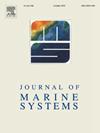The pelagic zone is home to a large diversity of organisms such as macrozooplankton and micronekton (MM), connecting the surface productive waters to the mesopelagic layers (200-1000 m) through diel vertical migrations (DVM). Active acoustics complement net sampling observations by detecting sound-scattering layers (SL) of organisms, allowing to monitor the MM dynamics with a high spatio-temporal resolution. Multi-frequency analyses are a pertinent approach to better integrate the rich diversity of organisms composing SLs and their respective dynamics. However, analysing simultaneously emitted acoustic signals with distinct depth ranges and separating spatial from temporal variability is challenging and needs adapted tools to be fully exploited. This study examines the pelagic realm in a transition zone between the Southern Ocean and the subtropical Indian Ocean, crossing the Saint-Paul and Amsterdam islands’ natural reserve. We extended a Multivariate Functional Principal Component Analysis (mfPCA) to analyse the joint vertical variation of five frequencies from two oceanographic cruises (2016 and 2022), allowing the decomposition of the acoustic dataset into orthogonal vertical modes (VM) of variability. We found the first VM to be linked to the temporal variability due to DVM, while the following majorly depict patterns in spatial distribution. Overall, from the subantarctic to the subtropical zones, we observed (i) enrichment of densities in the surface layer (0–100 m), (ii) a decrease in densities in the intermediate layer during the daytime (100–300 m) and (iii) the apparition of an intensive deep scattering layer on the 38 kHz. We explored VMs’ connection with in-situ environmental conditions by clustering our observations into three distinct environmental-acoustic regions. These regions were compared with vertically integrated nautical area scattering coefficient distribution, a proxy for marine organisms’ biomass. Additionally, we analysed species assemblage changes from complementary cruises to further elucidate the observed acoustic distribution. We show that the mfPCA method is promising to better integrate the pelagic horizontal, vertical and temporal dimensions which is a step towards further investigating the control of the environment on the distribution and structuring of pelagic communities.


